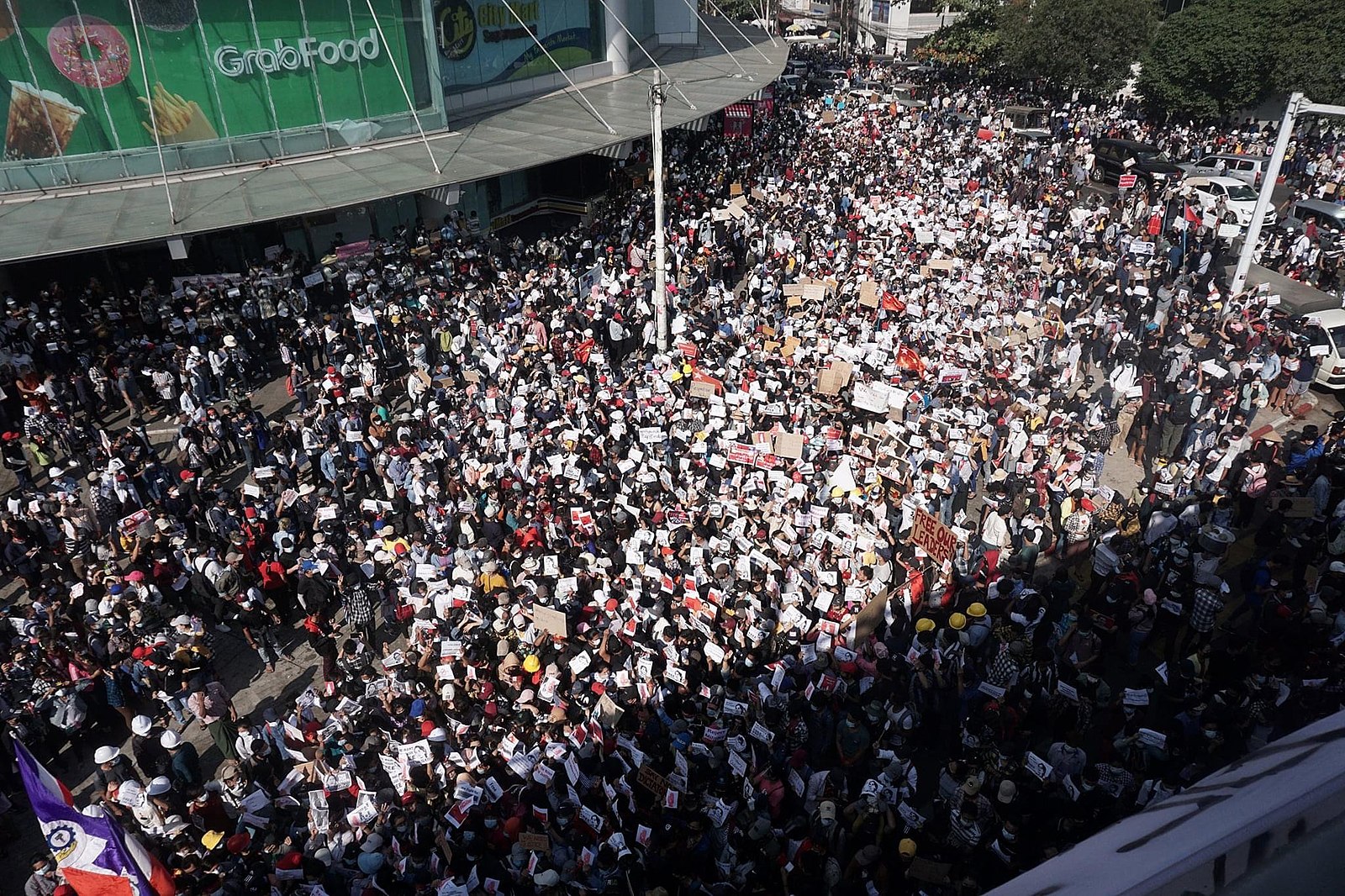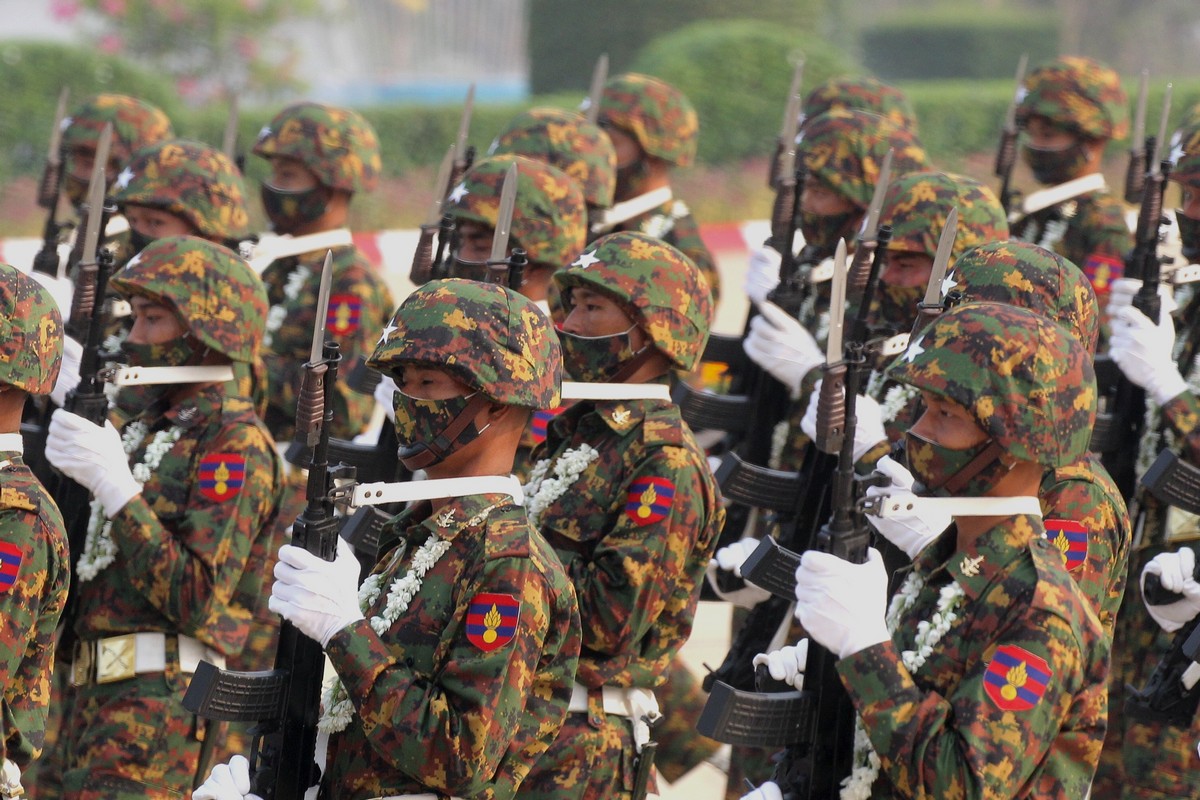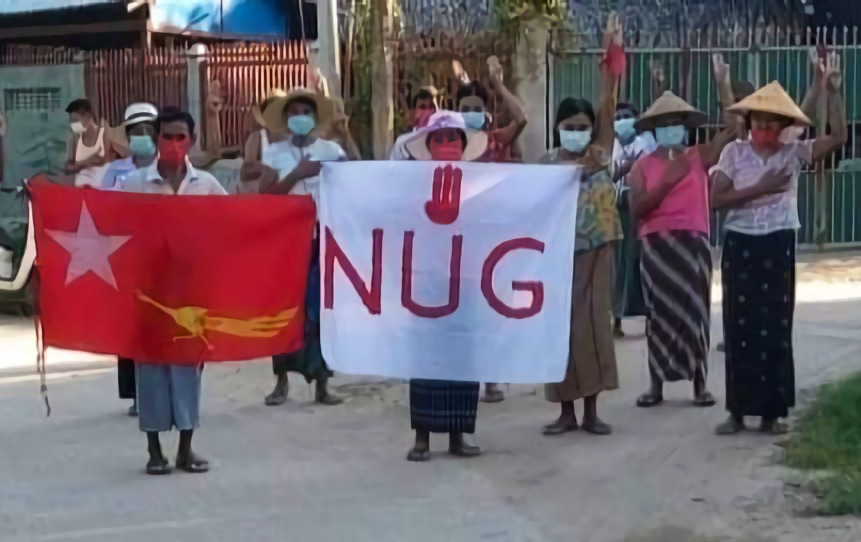On 7 September 2021, the self-proclaimed Interim National Unity Government (INUG) declared a state of emergency and declared a civil war against the military junta. It is not difficult to declare war online by announcing a state of emergency. It is even easier for those who are safely in exile in the United States. If you have a good internet connection, you can declare war at the stroke of a keyboard.
Before INUG announced this state of emergency, there was a false hope among many people in Myanmar that all of the anti-junta militias would wage an insurrection on 'the same day' against the junta. Many also expected INUG would call for D-Day when the PDFs and guerrilla armed forces are ready to fight against the junta. After that, victory will ensue. This rumor was spread by the so-called online social influencers, who are also diehard supporters of NLD and the INUG. The latter’s pronouncement on 7 September, then, renewed this hope among the people.
However, carrying out an armed uprising to overthrow a military dictatorship is not as simple as making an announcement online. Even a child knows this fact. Everyone knows that armed insurrection is a serious matter, and not something you can suck out of your thumb artificially at will at any moment. Yet the INUG and their supporters often wrote that the cruelty of those “war demons” in the “fascist” military is so intolerable that the people have no choice but to answer their call to take up arms.
The despicable cruelty on the part of the military of course cannot be disputed. However, if it could be simply toppled by a call to the people to fight their cruelty, revolutions would occur across the whole world overnight and the world we all aspire to could have been realised long ago.
An armed struggle cannot be waged based on sentimentality alone. Marx once said that insurrection is an art and it must be taken seriously. Lenin added:
“To be successful, insurrection must rely not upon conspiracy and not upon a party, but upon the advanced class. That is the first point. Insurrection must rely upon a revolutionary upsurge of the people. That is the second point. Insurrection must rely upon that turning-point in the history of the growing revolution when the activity of the advanced ranks of the people is at its height, and when the vacillations in the ranks of the enemy and in the ranks of the weak, half-hearted and irresolute friends of the revolution are strongest. That is the third point.” (Marxism and Insurrection, Lenin, September 1917)
Just one month before the 1917 October uprising, Lenin reiterated Marx’s teachings that insurrection must be treated as an art and he specified the objective conditions under which an insurrection could be called for. In September 1917, Lenin urged the Bolshevik Central Committee to conclude that an armed uprising was on the order of the day, for all three objective conditions had been fulfilled. In the same letter, however, he also explained that there was no such situation on 3-4 July, and that the insurrection could not have been successful at that time.
At that time:
“(1) We still lacked the support of the class which is the vanguard of the revolution.
We still did not have a majority among the workers and soldiers of Petrograd and Moscow. Now we have a majority in both Soviets. It was created solely by the history of July and August, by the experience of the ‘ruthless treatment’ meted out to the Bolsheviks, and by the experience of the Kornilov revolt.” (Ibid.)
That explains why in July the Bolsheviks, led by Lenin and Trotsky, tried to restrain the spontaneous uprising of the soldiers who came to them. In Petrograd, the capital city, they could have seized power. But they postponed it as they considered it premature. They adopted the tactic of “patiently explaining” to win over the majority of the vanguard* class of the revolution to their program.
(*NB: the word “vanguard’” was used widely during the period of the Burmese Revolution. Some groups of people used to call themselves a “vanguard” despite the fact that they were a handful of men. Some people described INUG as the “vanguard”. It is clear that they do not understand the real meaning of the concept of “vanguard”. Marx and Lenin firmly maintained that the vanguard class of the revolution is the working class, not the peasants, not the students - although they can be allies of the working class - and certainly not the bourgeois liberals.)
Lenin continues:
“(2) There was no country-wide revolutionary upsurge at that time. There is now, after the Kornilov revolt; the situation in the provinces and assumption of power by the Soviets in many localities prove this.”
“(3) At that time there was no vacillation on any serious political scale among our enemies and among the irresolute petty bourgeoisie. Now the vacillation is enormous. Our main enemy, Allied and world imperialism (for world imperialism is headed by the “Allies”), has begun to waver between a war to a victorious finish and a separate peace directed against Russia. Our petty-bourgeois democrats, having clearly lost their majority among the people, have begun to vacillate enormously, and have rejected a bloc, i.e., a coalition, with the Cadets.” (ibid.)
Are any of the objective conditions that Lenin examined present in the country today? Let us consider the situation.
The working class, the vanguard class of the revolution, had fought on the front lines since early February 2021. They fought on the streets, while the middle class liberals fell for the military’s false propaganda online, which said that this was not a coup - that the military (also known as “sit-tat”) were just holding power for a brief period, and that the masses should stay at home so as not to provoke them.
It is obvious which class is the vanguard of the revolution by just looking at this one fact. Not only that, but the general strike of the working class in all walks of life had paralysed the whole of society, bringing the rest of the oppressed people into the revolution.
 In February and March, the working class fought back valiantly but was unable to form a revolutionary party made up of its most advanced elements. That is what allowed liberal bourgeoisie to occupy the position of leadership. / Image: public domain
In February and March, the working class fought back valiantly but was unable to form a revolutionary party made up of its most advanced elements. That is what allowed liberal bourgeoisie to occupy the position of leadership. / Image: public domain
This is what happened at the end of February and March. The working class fought back valiantly but was unable to form a revolutionary party made up of its most advanced elements. That is what allowed liberal bourgeoisie to occupy the position of leadership. This situation is similar to one where “lions are led by donkeys”, as the English saying goes.
So, what is happening to the vanguard class of the revolution in the present period? They are exhausted after such a long period of strikes and street protests, after seeing all their struggles fail to remove the military, and they are forced to work for the miserly wage of 3600 kyats (equivalent to US$2), which is lower than the official minimum wage of 4800 kyats (US$3) for eight hours a day.
To be successful, an insurrection must base itself on the vanguard class of the revolution. How can one expect the working class to launch this when they are in a state of exhaustion? How do you wage an armed uprising at a time when even trade unions cannot be organised? Or are we imagining here a scenario where one can simply drive the mass of urban population, and the working class in particular, into the jungle for military training to carry out an insurrection?
Marx and Lenin fully understood that it is not enough to have an uprising of the advanced class alone for the revolution to be successful. That is why they emphasised, as a second point, that there must be a nationwide revolutionary upsurge of the entire people.
We have to ask ourselves honestly whether there is such an upsurge in Burma. Yes, there was such a nationwide revolutionary upsurge in the last days of February and March, but not now. Does the flash mob activity of tens of people shouting for a few minutes: “Accept NUG, Reject Military” indicate that the revolutionary tide is on the rise? Or is it presently in deep decline? Everyone with a thinking brain knows what the answer to that question is.
As to the third point, that we must base ourselves on a turning point in the history of the growing revolution, what conclusions can we draw? By assessing if the revolution is growing or has ebbed, one can clearly see that there is a lack of the third condition.
The vanguard class is merely struggling for the means of subsistence so as not to die from starvation. The advanced ranks of the people are so weakened that they cannot even fight back against the daily forms of oppression in the workplaces. Is this situation a turning point in the history of a growing revolution or is it the period of suffering under the white terror of counter-revolution? It is necessary to make a sobre analysis of the current situation.
Marx and Lenin would have defined calling for an insurrection in such a situation as “Blanquism”. For those unfamiliar with this term, it can be understood as “adventurism”. Adventurism is usually a result of a leadership that previously attempted opportunistic tactics and failed miserably, only to swing to the ultra-left that would also lead to failure. There are many precedents of this in history. In the 1920s, Trotsky criticised the way that the bureaucratised Comintern led the Chinese Communist Party to go from adapting to the bourgeois KMT into leading premature insurrections against it:
“The strength of Marxism lies in its ability to foretell. In this sense, the Opposition can point to a complete confirmation of its prognoses by experience: first, concerning the Guomindang as a whole, then concerning the ‘Left’ Guomindang and the Wuhan government, and finally, concerning the ‘deposit’ made on the third revolution, that is, on the Canton insurrection. What other confirmation could there be of a correct theoretical standpoint?”
“The very same opportunist line which, by the policy of capitulation to the bourgeoisie, already brought the revolution, at its first two phases, the heaviest defeats, ‘grew over’ in the third phase, into a policy of adventurous attacks upon the bourgeoisie, and made the defeat final.”
Not having understood why the revolution failed, there can be the tendency to blame the working class itself for the failure, instead of understanding the need to build a mass revolutionary party of the working class. This in turn, can either lead to ultra-left tendencies or opportunist tendencies, or even a combination of both. And in both cases there is no independent role for the working class, which must either hope in salvation at the hands of the armed guerrillas or the liberals and reformists.
One should never play with insurrection
An armed uprising is a special form of the political struggle which is subject to special laws. Marx, who said to treat the insurrection as an “art”, also explained the principal rules of this form of struggle, as Lenin explained:
“(1) Never play with insurrection, but when beginning it realise firmly that you must go all the way.”
“(2) Concentrate a great superiority of forces at the decisive point and at the decisive moment, otherwise the enemy, who has the advantage of better preparation and organisation, will destroy the insurgents.”
“(3) Once the insurrection has begun, you must act with the greatest determination, and by all means, without fail, take the offensive. ‘The defensive is the death of every armed rising.’”
“(4) You must try to take the enemy by surprise and seize the moment when his forces are scattered.”
“(5) You must strive for daily successes, however small (one might say hourly, if it is the case of one town), and at all costs retain ‘moral superiority’. (Advice of an onlooker, Lenin, October 1917)”
If we apply the principles of both Marx and Lenin we can only conclude that the online insurrection announced by INUG is like digging one’s own grave!
Conclusion
The objective conditions necessary for a successful insurrection have been outlined above. None of them are present at this time. In addition, the INUG’s actions reveal an extremely unserious attitude towards insurrections, contrary to what Lenin advised above. This has the danger of driving the advanced layers to adventurist methods, which in the present conditions can have very serious consequences, including the unnecessary deaths of many courageous workers and youth.
They are artificially making an insurrection online. Those who are actually dying on the ground on a daily basis are the workers, the peasants and other oppressed layers who cannot flee to America as the liberals did.
Therefore, the only logical conclusion of all this is that the INUG is not a revolutionary vanguard, nor is it an ally in the revolution. This layer of reactionary opportunists has merely usurped a leadership position. We must expose their treacherous role carrying out a ruthless criticism of them and find the correct revolutionary strategy and tactics.
 The bourgeois liberals of the INUG will never be consistent or serious in waging a war against the military, they are part of the capitalist class / Image: Mil.ru, Wikimedia Commons
The bourgeois liberals of the INUG will never be consistent or serious in waging a war against the military, they are part of the capitalist class / Image: Mil.ru, Wikimedia Commons
We have to understand that the bourgeois liberals of the INUG will never be consistent or serious in waging a war against the military. This is due to the fact that they are part of the capitalist class, and while they have their differences with the military over how to run the country, they fear the revolutionary mobilisation of the masses more than they fear the military regime. The way they declared the civil war - without any real, serious preparation on the ground - reveals this abundantly clearly.
Things are, however, different when it comes to workers and youth activists who are sincere about waging an armed struggle that can lead to an insurrection and the overthrow of the regime. While we agree with their burning desire to topple the military, we must look at the present conditions objectively and see whether an insurrection is possible at this time. What we are discussing here is not whether we are for or against revolutionary methods, including insurrection, to overthrow the present regime. The discussion is about the concrete objective conditions we find ourselves in.
We need to look at what kind of revolution is necessary. Is it to be a democratic revolution that preserves capitalism intact and place the bourgeois liberals back in office, or ist it to be a socialist revolution which places the working class - in alliance with the peasants - in power?
If you study the works of Marx and Lenin, you will find that the Stalinist/Maoist “protracted warfare” strategy, which relies solely on the peasantry, is also flawed. The peasantry can be won to a genuine socialist revolution, as the Bolsheviks managed to achieve in the October Revolution, but the leading role belongs to the working class, as it did back in 1917. Where peasant guerrilla wars have succeeded, such as in China in 1949, the working class did not achieve healthy workers’ democracy. This also explains the present situation in China where capitalism has been restored, but that requires a more in depth analysis than can be given here.
The urgent task today is to return to the basic ideas of Marx and Lenin, understand the role of the working class in society and begin the building of a Marxist cadre organisation around which a future mass revolutionary party of the working class can be formed in the future when the working class and youth rise up again.
This road may seem arduous and long, but there are no shortcuts that can bring into being such a mass party. We must learn the lessons of the past, of our own past here in our country, the failed attempts at armed struggle in the 1950s and 1980/90s, and the experience of other countries as well.

